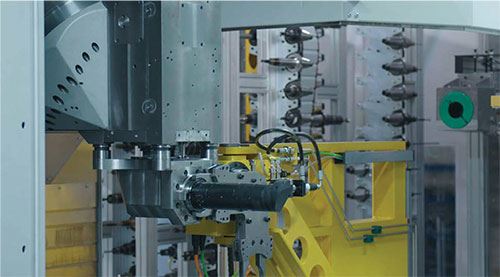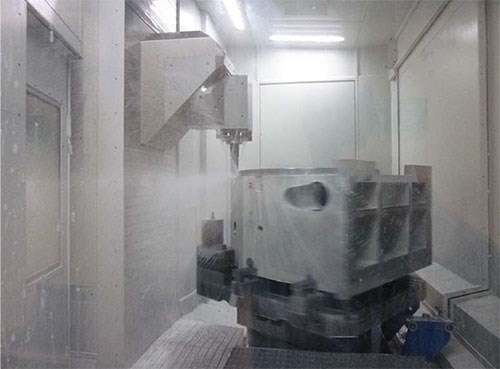Technology for Turning on a Five-Axis Machine
A turning tool adapter that mounts to the MCT five-axis machine isolates the main spindle bearing from the shock of turning operations.
Share





Five-axis machine tools combine linear XYZ travels with A- and B-axis rotation to enable the machining of five sides of a part in one setup. Some are used to perform 3+2 operations, whereby the part is rotated and locked into an angled position, and the machine essentially performs a three-axis operation with the part oriented in that way. Others can execute more complex, full-contouring five-axis operations that use simultaneous linear and rotational motions to pass a cutting tool over a contoured surface.
In some cases, attachments can be used to enable these machines to perform turning operations, too. However, when static turning tools are mounted directly into a machine’s main spindle, as they typically are, the shock loads common to turning can eventually lead to spindle bearing damage.
This has spurred Burkhardt + Weber, part of Industrias Romi SA, to develop its MCT line of five-axis machines. The MCT series includes five machine models that can turn parts ranging in diameter from 11.8 to 110 inches and weighing as much as 8,818 pounds at a maximum rotational speed of 600 rpm (workpiece capacity when turning is not performed is 15,432 pounds). These machines feature the following integral design elements said to enable productive turning, even for non-symmetrical parts, without causing damage to the spindle bearing system:
Turning tool adapter. With the conventional approach of inserting a static turning tool into a five-axis machine’s spindle, the spindle rotor is often clamped to the spindle’s outer housing in order to lock it in a stationary position to protect against possible turning shock loads. Lighter cuts are also typically performed to prevent bearing damage, but this leads to lower productivity.
Conversely, the MCT machines feature an automatically exchanged tooling adapter that mounts to the spindle housing via a zero-point clamping mechanism, isolating the spindle bearings from the shock of turning operations. The system uses four clamping cylinders located 9.84 inches apart and supplies 26,400 pounds of clamping force to secure the turning tool adapter to the spindle housing. Turning tools can be automatically loaded and unloaded into the adapter just like a milling tool from the machine’s ATC.
Table balance control. Because parts to be turned on a five-axis machine often aren’t symmetric, the MCT machines feature a compensating balance-control system. After a part or pallet is loaded and securely clamped to the machine’s table via a mechanical spring-based safety system, a balancing cycle is automatically performed at 80 rpm using sensors to measure rotational forces. Afterwards, a display on the machine’s CNC shows the location and amount of counterweight required to bring the system into balance. Turning operations can proceed once balance quality is confirmed after another 80-rpm test cycle.
Thermal isolation system. Torque motors in rotary tables used for turning on a five-axis machine generate a good deal of heat, causing unpredictable expansion and contraction of a machine’s frame that can adversely affect accuracy and repeatability. Rather than using complex temperature-compensating software algorithms and sensor feedback, the MCT machines remove heat surrounding the table and frame with an actively controlled cooling system, stabilizing the frame by maintaining a consistent temperature. In addition, the company developed a non-contact, 16-channel hydraulic rotary sealing system for the machine line’s 600-rpm tables that does not generate heat due to friction or wear of mating seal surfaces common to
conventional systems.
Related Content
Inverting Turning and Five-Axis Milling at Famar
Automation is only the tip of the iceberg for Famar, which also provides multitasking options for its vertical lathes and horizontal five-axis machine tools.
Read MoreWhich Approach to Automation Fits Your CNC Machine Tool?
Choosing the right automation to pair with a CNC machine tool cell means weighing various factors, as this fabrication business has learned well.
Read MoreBallbar Testing Benefits Low-Volume Manufacturing
Thanks to ballbar testing with a Renishaw QC20-W, the Autodesk Technology Centers now have more confidence in their machine tools.
Read MoreCNC Machine Shop Honored for Automation, Machine Monitoring
From cobots to machine monitoring, this Top Shop honoree shows that machining technology is about more than the machine tool.
Read MoreRead Next
Setting Up the Building Blocks for a Digital Factory
Woodward Inc. spent over a year developing an API to connect machines to its digital factory. Caron Engineering’s MiConnect has cut most of this process while also granting the shop greater access to machine information.
Read MoreRegistration Now Open for the Precision Machining Technology Show (PMTS) 2025
The precision machining industry’s premier event returns to Cleveland, OH, April 1-3.
Read More5 Rules of Thumb for Buying CNC Machine Tools
Use these tips to carefully plan your machine tool purchases and to avoid regretting your decision later.
Read More






















.jpg;maxWidth=300;quality=90)









